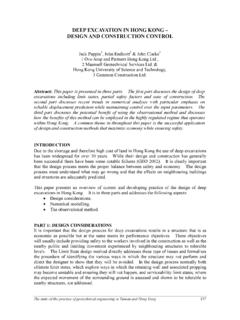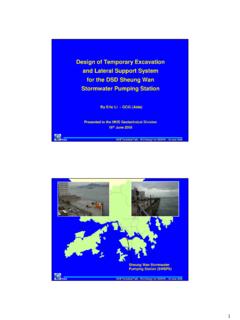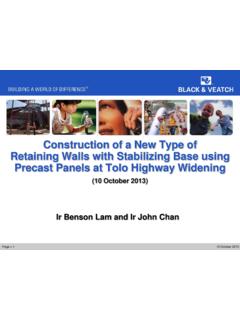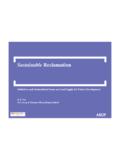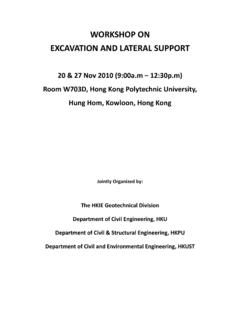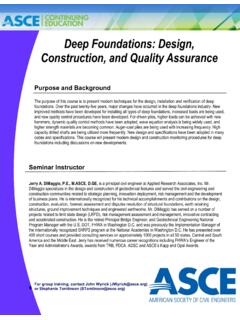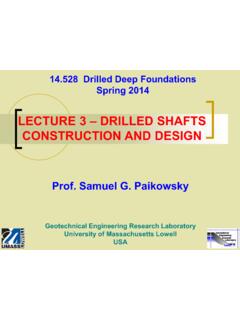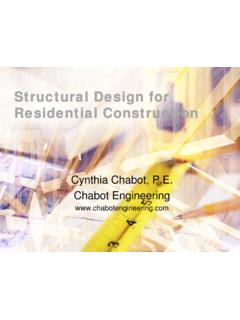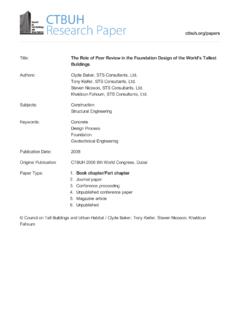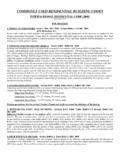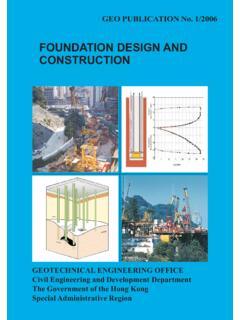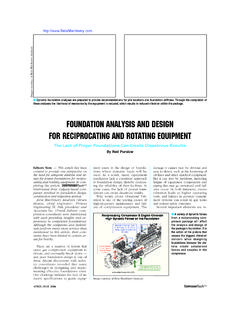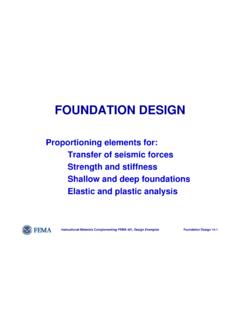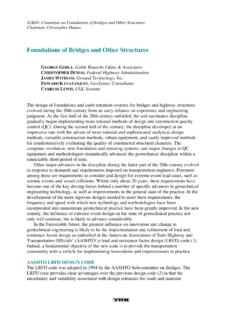Transcription of Foundation Design & Construction in Hong Kong – …
1 1 Foundation Design & Construction in hong Kong Present & Beyond?Daman Lee Ove Arup & Partners hong Kong Pun Geotechnical Engineering Office, CEDDA rthur So China State Construction Engineering ( hong Kong) Wai Gammon Construction LimitedThe State-of-the-practice of Geotechnical Engineering in Taiwan and hong KongOur Theme A brief look at where we are Issues still bugging us Where do we go now?2 Common Foundation Types in hong KongMini-pilesSteel H pilesDrivenPrebored1MN4MN6 MNUp to100 MNLarge diameter bored pileNew Publications in hong Kong1 / 20063 Progress in Last 5 Years ..Li et al (2000) Design of Deep foundations in hong Kong Time for change? (1) End Bearing Bored Piles on Rock Predominately using presumptive values Bearing pressures generally regarded as very conservativeGEO Publication 1/2006 provides an alternative approach4(2) Bell-out / Rock SocketTypically 5 MPaTypically 10 MPa Many queried the actual effectiveness of bell-out (egLumb) A convenient way to address bearing pressure being too conservative?
2 Half-addressed by Code of Practice for Foundation (BD, 2005)(3) H-pile Driven to Rock Shallow rockhead Pile driven into rock Loading tests tend to produce positive resultsShallow rockheadAddressed by Code of Practice for Foundation (BD, 2005)5(4) Negative Skin Friction Drag on piles due to settling ground Transient loads results in temporary settlement Need to consider a combined load case of both?SettlinggroundAddressed by Code of Practice for Foundation (BD, 2005)(5) Issues Requiring More Progress Use of hydraulic hammer to achieve final set Bored pile on rock how to deal with soft materials at the interface6 Bored PilesDesign & Construction Issues with Bored Piles Bearing pressure on rocks Combined end bearing and rock socket 45 load spread Pile base imperfections7 Bearing Pressures on Rock First appear in 1990 Considered to be very conservative Many full-scale pile loading tests had been undertaken since Used until 2005 Loading Tests by West Rail Presented in many previous occasions In the Technical Memorandum, 50% increase in bearing stresses were approved by BD Various other loading tests also support this051015202530050100150200250 Average unconfined compressive strength (MPa)End bearing stress qb (MPa) (1)(14)(2)( )(13)(2-3)(30)(11)(11)(130(15)(12)(11)(1 )(30)(7))
3 PNAP141 West Rail8 Bearing Stresses in the New Code of Practice for foundations (BD, 2005) A new prescriptive bearing stress for highly to completely decomposed rocks No change to the other categories A new prescriptive bearing stress for fresh rock note the requirement of 100% total core recovery (TCR) and no weathered jointsEnd Bearing on Rock Alternative to Presumptive Values 0 5 10 15 20 25 30 0 10 2030405060708090100 Rock Mass Rating (RMR)Allowable Bearing Pressure (MPa) Bearing pressure that can induce settlement of about 1% of the pile diameter at the pile base. Recommended allowable bearing pressure Mobilized Bearing Pressure, qa (MPa) 88 Legend: ? = Bearing pressure substantially mobilised ? = Degree of mobilisation of bearing pressure unknown Mobilised Bearing Pressure q (MPa)Rock Mass Rating (RMR)Recommendedallowablebearing pressureBearing pressurethat can inducesettlement of ~1%of the pile the baseExtracted from GEO Publication 1/2006 (In Press)9 The Use of Rock Socket Data published in recent years Many used OsterbergCell at pile base -direct measurement of socket behaviour 100100010000110100 1000 Uniaxial Compressive Strength of Rock, qc (MPa) Uniaxial Compressive Strength of Rock, c (MPa) Mobilized Shaft Resistance in Rock, (kPa) s = c Legend: ?
4 = Shaft resistance substantially mobilised ? = Degree of mobilisation of shaft resistance unknown Figure 19 Mobilized Shaft Resistance in Rock Sockets Extracted from GEO Publication 1/2006 (In Press)1001000100001101001000 Unconfined compressive strength of rock (MPa)Ultimate shaft friction s (kPa)Horvath et al (1980)Williams & PellsGeoguide 1/96 Uniaxial Compressive Strength, qu(MPa)Horvath et al (1980)Long & Collins (1998)Radhakrishnan & Leung (1989)Williams & Pells (1980)Glos & Briggs (1983)Shiu & Chung (1994)Lam et al (1991)Arup tests in HKKCRC West Rail testsZhan & Yin (2004)Ultimate socket friction, s(kPa)GEO Publication No. 1/96 Incheon 2ndBridge (2005) s= quCode of Practice 2004 Extracted from West Rail papersLoad Deflection Behaviour of Rock Sockets This is where The bullet points Are to go10 Combined Rock Socket and End Bearing Rock socket behaves in a ductile manner Should allow direct combination of both without the need of further loading test Provide a robust alternative to the use of bell-out if the socket length to pile diameter ratio is around 3 Max ratio allowed by BD (2005) is 2 (or 6m whichever is less)45 Load SpreadUnder the strange rule, there is no need for any load spread check in this case!
5 11 Pile Toe Imperfections Major issue a few years ago Less so nowadays, but not completely resolved The use of pressure grouting is still routinely done as a remedial measureStudy by the HK Contractor Association (2001-2002) Thin layer of soft materials at pile base does not always require remedial works Factors to be considered: A single pile or pile group? Probing at centre of pile or edge of pile? unbound aggregate, soil inclusions or coreloss Suggested a rational approach to the problem12 This is where The bullet points Are to go Interface Soft Layer Thickness Investigation Remedial Wo r k s / P r o p o s a lFurther Investigation Remedial Wo r k s / P r o p o s a lS 100 N/A Flush clean + normal grout N/A N/A 100 < S 150 N/A Flush clean + pressure grout N/A Sonic test (Fan shape) with satisfactory results Flush clean + pressure grout N/A N/A coring for second hole N/A S 100 Flush clean + normal grout 100 < S 150 Flush clean + pressure grout 150 < S 200 Unsatisfactory results 150 < S 200 Pressure jet clean + pressure grout S > 200 Further investigation + submit remedial proposal ConcretepileCoringtubeThicknessOf softMaterial -sPrescriptive Approach An ExampleDriven H-piles13 Design & Construction Issues with Driven H-piles Pile driving formula Final set problems Whipping of piles Long pilesShall We Keep Using Hiley Formulae?
6 Different views Simple is beautiful vs Too simple, sometimes .. If we were to vote ..examples14 The Driving Formulae Hiley (1925) In 1960, more than 450 formulae of slight variations to Hiley HKCA (1994) lumped various efficiency terms into a single factor Kh HKCA (2004) uses energy measured from PDA Gradually increasing experience in modelling the efficiency of hydraulic hammers in Hiley Formula Difficulties encountered in long pilesDevelopment of the Wave Equation Isaacs (1931) First used 1-D stress wave theory in pile driving analysis Smith (1960) forms the basis of modern wave equation analysis Development of bonded resistance strain gauges Research work at Case Institute of Technology CAPWAP, GRLWEAP At present, limited to detect pile defects, measure hammer efficiency15A State of Confusion Different departments have different approaches ASD approach: Use of CAPWAP to determine pile capacity and calibrate against parameters in the Hiley Formula Private projects.
7 Essentially HKCA (1994), with trial piles to establish khand PDA/CAPWAP Contractors do not know how small the set needs to be in order to pass the loading testsLong Piles Big Hammers Ideal Situation: SPT N > 200 at around 30-40m; set usually achieved 3-5m into the saprolite For longer piles, the length effect of Hiley Formulae starts to show Even 20t hammers dropping from 4m is not enough So-called Driving to refusal 16 Required Set for Long Piles at a Particular Site(over 4000 piles, 35-80m long)Hypothetical Allowable Set17 Whipping of PilesWhy Does This Happen? Happens mostly in sites with soft deposits in the upper layers (eg reclamation) Let go in its weaker axis with insufficient lateral restraint during driving Some contractors attempt to avoid this by reducing the drop height and carry out final set a few days later18 Signs of Whipping from Shaft Shortening Measurements Static load tests carried out at a particular site with thick layer of soft soils Signs of whippingMore to Tackle.
8 Residual settlement on pile loading tests Use of pile raft (settlement reducing piles) Use of base-grouting in competent soils Ultimate limit state Design ? etc etc Encourage rational designs when time and resources are available19 Thank YouTypical Set TableTYPE OF PILE:305x305x223 kg/mUNIT WEIGHT OF PILE:223 kg/mDRIVING RESISTANCE(R) :7096 kN <=3548x2 DROP OF HAMMER(h) mTYPE OF HAMMER:Drop Hammer (DH-06)EFFICIENCY OF HAMMER(k) OF HAMMER OR RAM(W) kNCOEFFICIENT OF RESTITUTION(e) (Steel Anvil)WEIGHT OF PILE HEAD HELMET(WH) kNTEMPORARY COMPRESSION OF PILE HEAD (Cc) mmENERGY OUTPUT PER BLOW (MAX)(W*h) :642 of blow :S = ( W * h * k * ) / R - C / 2 WHEREC = Cp + Cq + Cc=W+P*e^2 WHEREP = WEIGHT OF PILE AND HELMETW+ - - - - - 504540353025 - - - - - 4944393429 - - - - - - - - 4742373227 - - - - - - - - 4641363126 - - - - - - 504540353025 - - - - - - - 4944393429 - - - - - - - - 4742373227 - - - - - - - - 4641363126 - - - - - - - Allowable Penetration (mm) For Last 10 Blows TableTemporary Compression Cp+Cq (mm)Pile Length (m)Blow Efficiency FelleniusE.
9 Blackettretur
